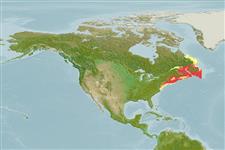>
Perciformes/Cottoidei (Sculpins) >
Agonidae (Poachers) > Hemitripterinae
Etymology: Hemitripterus: Greek, hemi = half + Greek, tres, tria = three + Greek, pteron = wing, fin (Ref. 45335).
More on author: Gmelin.
Environment: milieu / climate zone / depth range / distribution range
Ökologie
seewasser demersal; tiefenbereich 2 - 180 m. Temperate; ? - 16°C (Ref. 27549); 58°N - 36°N, 76°W - 50°W
Northwest Atlantic: Labrador in Canada to Chesapeake Bay in USA.
Size / Gewicht / Alter
Maturity: Lm ? range ? - ? cm
Max length : 68.0 cm TL Männchen/unbestimmt; (Ref. 49746); max. veröff. Gewicht: 3.2 kg (Ref. 7251)
Inhabit rocky or hard bottom and is a voracious eater. Food includes crustaceans, mollusks, sea urchins, fishes such as herring, sand lance and silver hake, and any bottom invertebrates that are available. When taken out of the water the belly becomes inflated so that when returned to the water they are unable to submerge. Adults attach their eggs near the base of a sponge to use as a spawning bed (Ref. 34819, 41075).
Life cycle and mating behavior
Maturities | Fortpflanzung | Spawnings | Egg(s) | Fecundities | Larven
Adults attach their eggs near the base of a sponge to use as a spawning bed (Ref. 34819, 41075).
Robins, C.R. and G.C. Ray, 1986. A field guide to Atlantic coast fishes of North America. Houghton Mifflin Company, Boston, U.S.A. 354 p. (Ref. 7251)
IUCN Rote Liste Status (Ref. 130435)
Bedrohung für Menschen
Harmless
Nutzung durch Menschen
Köder: occasionally
Tools
Zusatzinformationen
Download XML
Internet Quellen
Estimates based on models
Preferred temperature (Ref.
123201): 0.5 - 10.2, mean 3.8 °C (based on 130 cells).
Phylogenetic diversity index (Ref.
82804): PD
50 = 0.6289 [Uniqueness, from 0.5 = low to 2.0 = high].
Bayesian length-weight: a=0.00501 (0.00197 - 0.01276), b=3.15 (2.93 - 3.37), in cm total length, based on LWR estimates for this (Sub)family-body shape (Ref.
93245).
Trophic level (Ref.
69278): 4.5 ±0.5 se; based on diet studies.
Widerstandsfähigkeit (Ref.
120179): sehr niedrig, Verdopplung der Population dauert mehr als 14 Jahre. (Preliminary K or Fecundity.).
Fishing Vulnerability (Ref.
59153): Moderate to high vulnerability (47 of 100).
Nutrients (Ref.
124155): Calcium = 32.1 [17.3, 64.8] mg/100g; Iron = 0.341 [0.174, 0.650] mg/100g; Protein = 17.2 [15.9, 18.5] %; Omega3 = 0.575 [0.254, 1.525] g/100g; Selenium = 17.2 [8.4, 40.8] μg/100g; VitaminA = 24.2 [7.4, 79.7] μg/100g; Zinc = 0.423 [0.300, 0.618] mg/100g (wet weight);
